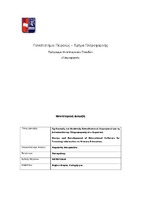Σχεδιασμός και ανάπτυξη εκπαιδευτικού λογισμικού για τη διδασκαλία της πληροφορικής στο δημοτικό
Design and development of educational software for teaching Informatics in primary education

View/
Subject
Εξ αποστάσεως εκπαίδευση ; Διδασκαλία βοηθούμενη από ηλεκτρονικό υπολογιστή ; Εκπαίδευση, Πρωτοβάθμια -- Διδασκαλία με τη βοήθεια ηλεκτρονικού υπολογιστή ; Εκπαιδευτικό λογισμικόKeywords
Πληροφορική -- Μελέτη και διδασκαλίαAbstract
This dissertation is about the analysis, the designing, the development and the construction of educational software, for teaching children of elementary school classes the subject of Information Technology. The software was designed and built with PHP programming language; it contains question tests (quizzes) in order to make pupils get actively involved. These tests aim to the understanding of basic Information Technology meanings. The decision of the software’s content and it's structure, was based on the schedule of the Greek Ministry of Education, for the class of Information Technology for elementary school students.The fundamental educational purpose of the software of “compuland” is for students in elementary school to understand basic meanings of Information Technology and to recognize the differences between them. Furthermore, it aims to teach the use of these meanings through theory put into practice. The functional purpose of this software is also to create an interesting, user friendly environment of learning, which will allow students to grow skills while navigating and using electronic means of education, collaborated by multimedia applications.The purpose of this thesis is the creation of educational software of Information Technology, which contains theory basics that can be taught at the last grades of elementary school. The software has been divided into 3 autonomous parts, from the scope of the student. The first part is the software itself that contains the entire syllabus the student-user should be taught. For the software to be more interesting, multiple pictures are being used, graphics, simple and easy to understand texts, and user friendly dialog boxes etc. Moreover, the second part embeds the Quiz program itself. This part is to be used
by the teacher-user in order to construct and manipulate the exercises of the educational software as he thinks appropriate, depending on each student’s needs. Finally, the third part is to show the evaluation results by combining statistical data of use, after the completion of quizzes and the self¬evaluation of the student. Furthermore, the progress of each user-student is separately exported to a history user log, therefore provides both student and teacher a great opportunity of data feedback.


